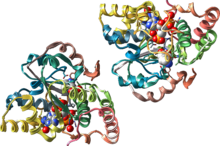In biochemistry, sulfotransferases (SULTs) are transferase enzymes that catalyze the transfer of a sulfo group (R−SO−3) from a donor molecule to an acceptor alcohol (R−OH) or amine (R−NH2).[1] The most common sulfo group donor is 3'-phosphoadenosine-5'-phosphosulfate (PAPS). In the case of alcohol as acceptor, the product is a sulfate (R−OSO−3):
| Sulfotransferase | |||||||||
|---|---|---|---|---|---|---|---|---|---|
 Crystal Structure of Human Sulfotransferase SULT1A3 in Complex with Dopamine and 3-Phosphoadenosine 5-Phosphate | |||||||||
| Identifiers | |||||||||
| EC no. | 2.8.2.- | ||||||||
| Databases | |||||||||
| IntEnz | IntEnz view | ||||||||
| BRENDA | BRENDA entry | ||||||||
| ExPASy | NiceZyme view | ||||||||
| KEGG | KEGG entry | ||||||||
| MetaCyc | metabolic pathway | ||||||||
| PRIAM | profile | ||||||||
| PDB structures | RCSB PDB PDBe PDBsum | ||||||||
| |||||||||
whereas an amine leads to a sulfamate (R−NH−SO−3):
Both reactive groups for a sulfonation via sulfotransferases may be part of a protein, lipid, carbohydrate or steroid.[2]

Examples edit
The following are examples of sulfotransferases:
- carbohydrate sulfotransferase: CHST1, CHST2, CHST3, CHST4, CHST5, CHST6, CHST7, CHST8, CHST9, CHST10, CHST11, CHST12, CHST13, CHST14
- galactose-3-O-sulfotransferase: GAL3ST1, GAL3ST2, GAL3ST3, GAL3ST4
- heparan sulfate 2-O-sulfotransferase: HS2ST1
- heparan sulfate 3-O-sulfotransferase: HS3ST1, HS3ST2, HS3ST3A1, HS3ST3B1, HS3ST4, HS3ST5, HS3ST6
- heparan sulfate 6-O-sulfotransferase: HS6ST1, HS6ST2, HS6ST3
- N-deacetylase/N-sulfotransferase: NDST1, NDST2, NDST3, NDST4
- tyrosylprotein sulfotransferase: TPST1, TPST2
- uronyl-2-sulfotransferase
- Estrone sulfotransferase
- Chondroitin 4-sulfotransferase
- other: SULT1A1, SULT1A2, SULT1A3, SULT1A4, SULT1B1, SULT1C2, SULT1C3, SULT1C4, SULT1D1P, SULT1E1, SULT2A1, SULT2B1, SULT4A1, SULT6B1
See also edit
References edit
- ^ Negishi M, Pedersen LG, Petrotchenko E, et al. (2001). "Structure and function of sulfotransferases". Arch. Biochem. Biophys. 390 (2): 149–57. doi:10.1006/abbi.2001.2368. PMID 11396917.
- ^ Rath VL, Verdugo D, Hemmerich S (2004). "Sulfotransferase structural biology and inhibitor discovery". Drug Discov. Today. 9 (23): 1003–11. doi:10.1016/S1359-6446(04)03273-8. PMID 15574316.
External links edit
- Sulfotransferases at the U.S. National Library of Medicine Medical Subject Headings (MeSH)
![{\displaystyle {\ce {R-SO3-}}\ +\ {\ce {R'-OH}}\quad {\xrightarrow[{\text{ SULT }}]{}}\quad {\ce {R-H}}\ +\ {\ce {R'-OSO3-}}}](https://wikimedia.org/api/rest_v1/media/math/render/svg/309f6adbd894014d72d03faf7b24c04b81e1f235)
![{\displaystyle {\ce {R-SO3-}}\ +\ {\ce {R'-NH2}}\quad {\xrightarrow[{\text{ SULT }}]{}}\quad {\ce {R-H}}\ +\ {\ce {R'-NHSO3-}}}](https://wikimedia.org/api/rest_v1/media/math/render/svg/b5606063c04db8ea36fe2dd0674ec64f45c93be9)